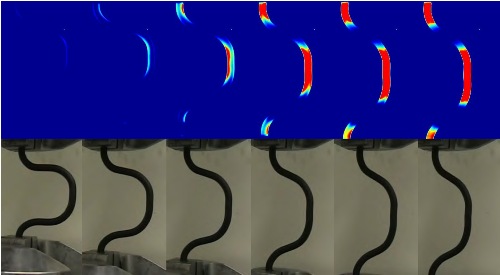Recent damages caused by earthquakes have shown how vulnerable existing structures are to strong disturbances in the ground. Researchers at the Georgia Institute of Technology are studying shape memory alloys and how they can be used in the construction of earthquake-resistant buildings.
 Georgia Tech researchers used a thermal camera to record the variation in surface temperature (top) of a shape-memory alloy experiencing loading and unloading. By inputting this information into their thermo-mechanical model, the researchers were able to accurately predict internal temperature and stress distributions for the material, which is being investigated for use in constructing seismic-resistant structures.
Georgia Tech researchers used a thermal camera to record the variation in surface temperature (top) of a shape-memory alloy experiencing loading and unloading. By inputting this information into their thermo-mechanical model, the researchers were able to accurately predict internal temperature and stress distributions for the material, which is being investigated for use in constructing seismic-resistant structures.
According to a professor in Georgia Tech-based School of Civil and Environmental Engineering, Reginald DesRoches, shape memory alloys display distinct properties that are needed for earthquake-resistant building and retrofit and bridge design applications. These alloys have the potential to dissipate considerable amounts of energy without any major degradation or permanent deformation.
The research team designed a model that integrates mechanical and thermodynamics equations to evaluate the result when shape memory alloys are loaded due to strong movement. The model is being used to assess how shape-memory alloys in a range of components that includes bars, cables, helical springs and plates react to a variety of loading conditions. Using the data obtained, it will be possible to determine the material properties for earthquake applications.
This thermo-mechanical model was described in a paper published online on Feb. 3 in the International Journal of Non-Linear Mechanics. This research was funded by the Transportation Research Board IDEA program. In order to enhance the performance of buildings during earthquakes, researchers globally have been studying the application of smart materials like shape memory alloys that can regain their original structure after being subjected to increased loads. The common shape-memory alloys are made of metal combinations that contain copper-zinc-aluminium-nickel, copper-aluminium-nickel or titanium-nickel.
Prospective applications of shape-memory alloys in building and bridge structures include their use in columns, bearings, beams or connection of elements between columns and beams. The impact of repetitive and extreme loads on these materials must be studied completely.
The Georgia Tech team discovered that the absorption and emission of heat during unloading and loading resulted in a temperature gradient in shape-memory alloys that caused an uneven stress distribution even when the strain is uniform.
Ambient conditions were included in the model as shape memory alloys for seismic applications could function in a number of environments that include air in building structures or bridge structures that would result in different heat transfer rates.
It was also possible to precisely predict internal temperature and stress distribution for shape memory alloys. The model results were evaluated with experimental tests. It was found that a gradually loaded shape memory alloy was able to exchange the created heat with the ambient environment and showed uniform stress. In case the loading was done rapidly, there was not enough time for heat exchange resulting in a non-uniform stress distribution.